Direct Marketing Lamb: A Pathway

By Dave Scott, NCAT Livestock Specialist
Abstract
This publication describes an alternative to marketing lamb other than as a commodity—and capturing the economic benefits. Successful marketing techniques are described, beginning with the finished lamb and continuing through the processing, pricing, and sale of whole and boxed lamb to today’s eager local foods customer.
Introduction
Marketing Tips: The Top Five
- Quality lamb sells!
- A good processor is key
- Pricing: Where to start?
- Selling the least desirables: You must!
- Know your profit: Use a cut-yield calculator
Loading your lambs up and hauling them to the sale ring is one way to market four seasons of devoted labor. It could, however, be debated whether you are really marketing at all—after all, you’re simply choosing a date and delivering your lambs to the sale ring on that day. Often, that date is determined not by market savvy, but by when you happen to run out of pasture. With today’s uncertain lamb markets, you may have no inkling of what lamb prices will be by the time your lambs are ready to sell. With this comes the frustration of trying to meet your financial obligations.
There is an alternative: direct marketing all or part of your yearly lamb crop. This approach is definitely more difficult than simply shipping the lambs as a commodity, but direct marketing through a number of different venues offers you economic opportunity that cannot be found in the local sale barn. Along the way, you may discover that you have skills that you did not know you possessed. The farmer entrepreneur learns to be a people person, becomes adept in basic marketing skills, is uncompromising in quality assurance, and is willing to adapt to changing customer demand. To these skills, others are added—skills of livestock evaluation, and superior carcass and cut recognition. The end result is the ability to offer an excellent product to the consumer, who will readily pay a value-added price—a price that allows the farmer to sustain his or her farm. This publication outlines a pathway for taking your lamb directly to today’s wholesome-food-conscious consumer.
Start with a Quality Product
High-quality lamb begins with a hearty animal raised in a wholesome environment. Often this includes spring and summer pastures with the young lamb alongside its mother. Depending on the breed and the length of the grass-growing season, weaned lambs may or may not be finished on grass pasture alone. Regardless of the production system used to finish your lambs, being able to determine when they are correctly finished is of utmost importance. As do most farm livestock, lambs put on muscle first and then marbling and fat cover. As the lamb matures, fat cover is noticeably built up along the backbone and in the loin areas. The presence of 0.2 to 0.25 inch of back fat between the 12th and 13th ribs indicates that the lamb is finished to the degree that yields both leanness and sufficient marbling for desirable taste and juiciness. In today’s market, fat is frowned upon. However, meat that is too lean, no matter how long it is aged, is likely to be tough and tasteless.
Looking for some quick information concerning options for direct marketing your lamb, the different levels of inspection required, and how much meat to expect from your live animals? See the ATTRA publication Tips for Marketing Sheep and Goat Products: Meat.
Finishing your lambs with the exact amount of fat that balances leanness with a delightful dining experience is your goal as a producer of fine-quality lamb. It takes some experimenting and feedback from your customers to determine the optimal amount of fat. The majority will prefer an animal finished with 0.20 inch of back fat. Remember that different breeds of sheep finish a little differently. You will need to find what is best for your own flock. Farmers markets provide an excellent source of customer feedback on your product.
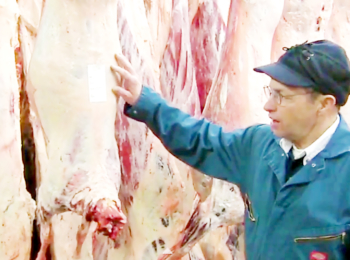
Evaluating your lambs as they hang in aging is highly informative. Here, Dave Scott assesses the finish on a group of his lambs. This one is nicely finished with 0.20 inch of back fat. Note that the lamb is tagged with ear tag number, process date, and hanging weight. Photo: Rich Myers, NCAT
A smaller-scale lamb producer has the opportunity to monitor the flock and select finished lambs frequently. If you have access to a processor that can process your lambs on a weekly or biweekly basis, you have a great advantage. Lambs finish at different rates and often what is a perfectly finished lamb one week can be a stale, overly fat lamb the next. A lamb producer who develops the skill of determining when a lamb is correctly finished, and who has a processor that can butcher that lamb in a timely fashion, will enjoy a market advantage over many of his competitors. For a demonstration of how to tell when a lamb is correctly finished, see the ATTRA video Putting a Hand on Them—How to Tell When Your Lamb is Finished.
The opportunity to select finished individual lambs at the proper time is not present in a large commercial feedlot, where animals must be fed in lots of a few hundred or more. To maintain biosecurity and to prevent disease outbreaks, “all in and all out” is the management protocol for each pen. Consequently, the law of averages is the rule, with some lambs being finished correctly and others being processed with too little or too much back fat. A skillful small producer-entrepreneur can capitalize on this opportunity and capture the discerning customer who demands a premium-quality meat and who will pay a premium price.
Finding a Processor
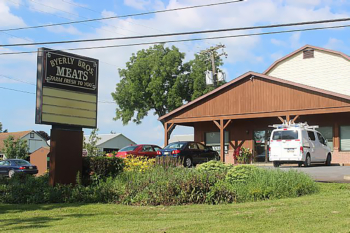
Finding a good processor is an important step in successfully marketing your lambs to the consumer. Processing your lambs at a USDA-inspected facility is necessary to market lamb across state lines. Photo: Norm Conrad, NCAT
Harvest and processing of your lambs are cornerstones in the successful marketing of your product. In most cases, they are also the components in the production chain over which you have the least direct control. All of your skill in producing and marketing your lamb comes to no avail if you do not succeed in securing the successful harvest of your lambs. For this reason, employing the services of a knowledgeable and reputable meat processor is of utmost importance. Remember that the processor must have appropriate inspection for the way you intend to sell your meat. For example, if you are selling to stores, restaurants, or farmers markets, State or Federal inspection is required. Federal inspection is required when selling across state lines. See the ATTRA publication Tips for Marketing Sheep and Goat Products: Meat for more information. Ideally, the processor should be relatively close to your farm. This limits the stress of hauling, allows you to easily view the hanging carcasses, and eases your transportation costs. Often, we producers know much more about the production part of our business than the processing end. A knowledgeable butcher who is willing to teach you the value of a good carcass and how to cut it expertly is invaluable. In my own experience, my operation has profited immensely from our meat cutter and processor. For more on lamb processing and how you can foster good relations with your butcher, see the ATTRA video Creating an Excellent Relationship with Your Lamb Processor.
Meat processors are busy people. Key to their success is keeping up plant throughput over the entire year. Anything you can do to make their life easier (especially communication) will be appreciated and earn you dividends in cooperation. Good processors are very hard to find; nurture the relationship with yours.
A Rule to Remember:
Communication + Consideration + Cash = Cooperation
– Linda Coffey, NCAT Ag Specialist
Minimizing Pre-Slaughter Stress
Loading and transporting the lambs to the processor is an important first step in processing that has a direct influence on the quality of the finished product. Lambs should be well rested prior to leaving the farm. This allows a buildup of glycogen in the muscle tissues. After the slaughter, rigor mortis (muscle firmness) takes place, and this glycogen is rapidly converted to lactic acid. Lambs that are stressed by improper and inhumane handling immediately prior to harvest have been shown to have low levels of glycogen and, consequently, minimal concentrations of lactic acid in post-slaughter muscle tissues (Chambers and Grandin, 2001). Proper muscle lactic-acid levels are responsible for producing meat that is tender, tasty, and can be preserved for a long period of time. Pre-slaughter stress greatly diminishes all three of these desirable qualities. Humane, soft handling of the lambs is not an option-it is essential.
Aging the Carcass
In general, dry aging lamb for seven days optimizes tenderness and flavor while minimizing weight loss from the carcass.
Aging follows harvest of the carcass. The amount and type of aging that is applied to the lamb carcass affects the tenderness and taste of the finished cuts. Processing that high-quality carcass is the next step towards winning over your customers with a distinctly superior product. For a close look at the procedure involved in aging, breaking down, and packaging a lamb carcass, refer again to the ATTRA video Creating an Excellent Relationship with Your Lamb Processor.
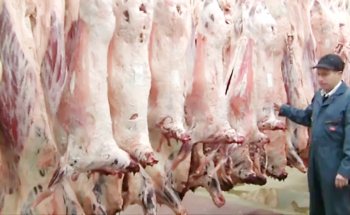
A group of lamb carcasses being dry aged. Dry aging
tenderizes and intensifies the flavor of the lamb. Photo: Rich Myers, NCAT
Although it must not be thought of as a cure-all, the aging process can alleviate the diminished tenderness that some unavoidable pre-slaughter stress (for instance, transport) produces. Ideally, the aging process consists of two components: drip cooling and dry aging. Immediately after slaughter, the carcasses are hung in a drip-cooling room at 33°F for 24 hours. The purpose of the cooling room is to rapidly cool and drain the carcass, without freezing the tissue. When the carcasses are cooled down, they are transferred to the dry-aging room. Here, the temperature is maintained at 33°F to 37°F and humidity at 75% to 85%. Additionally, air is circulated by fans. Very little mold is allowed to grow on the carcasses at this humidity and temperature. During this time, however, enzymes act on the protein molecules that bind together the contracting filaments of the muscle, causing the meat to become tender. As shown below in Figure 1, post-rigor mortis carcass tenderness increases sharply for seven days during aging and then gradually levels off.
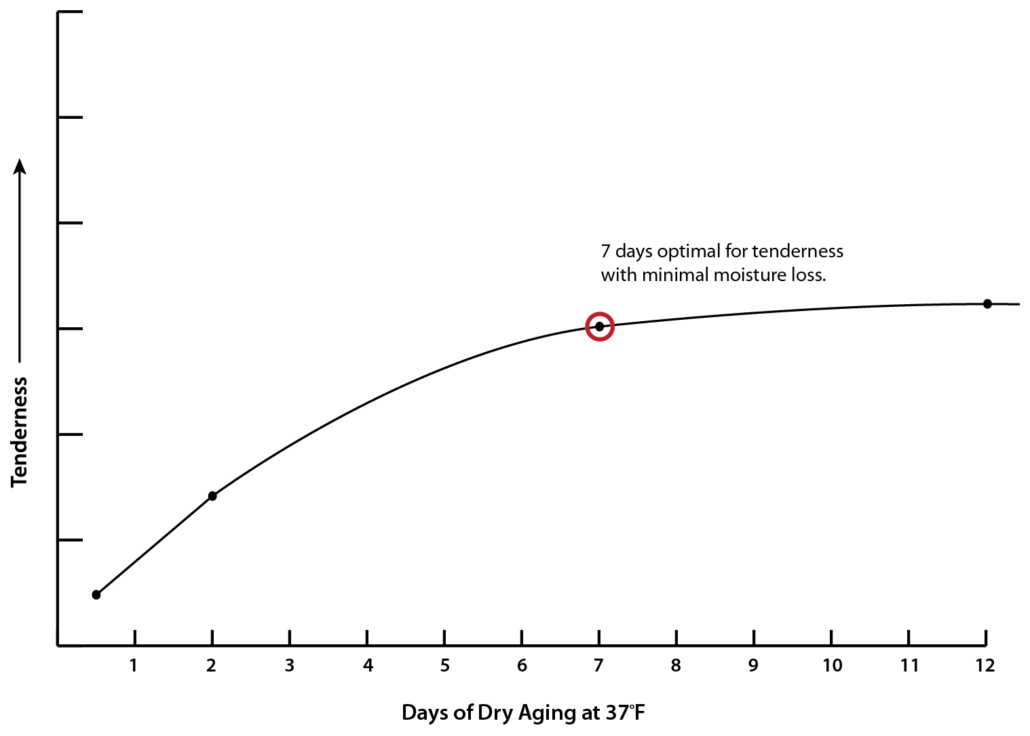
Figure 1. Amy Smith, NCAT
Concurrent with this rise in tenderness, there can be a 3% to 5% loss of moisture from the carcass (Schweihofer, 2011). Lamb carcasses with less fat cover typically have greater moisture loss during aging. As a check, we measured the cooling shrink in one run of 19 lambs that averaged 70 pounds hot hanging weight. After seven days of dry aging, we found a 3.20 % average shrinkage, which is within an acceptable range. If you encounter excessive cooler shrink in your lambs, you may want to look into your fat covering or the temperature and humidity of the dry-aging room. Additionally, during the dry aging, enzymes act upon the muscle tissues at the cellular level, breaking down proteins into amino acids and fats and fatty membranes into fatty acids. These smaller enzymatic reactions turn bland muscle tissue into a flavorful bite of meat. Discriminate cooking further enhances these chemical combinations to give dry-aged lamb a distinctive, mouthwatering flavor.
In general, dry aging lamb for seven days optimizes tenderness and flavor while minimizing weight loss from the carcass.
Case Study
Dave and Jenny Scott of Montana Highland Lamb run 200 ewes in Whitehall, Montana. Approximately 200 of their lambs are finished each year for direct sale to restaurants, grocery stores, and customers at farmers markets. The processor they had used for five years unfortunately closed his doors in the fall of 2013. It had been a very ideal situation for the Scotts, since this processor was only one mile from the farm. Typically, lambs were loaded, hauled, and harvested in an hour’s time. Dave and Jenny always felt that this greatly contributed to their lamb’s tender quality.
If they were to continue their retail lamb business, they would now have to haul their finished lambs 30 miles. Although they were concerned about the potential loss of tenderness due to the increased hauling, they decided to give it a try. The first lambs came back and a blindfold taste test was performed. The verdict was clear and their fears were realized-the meat lacked the tenderness they were accustomed to. Dave and Jenny felt that the hauling distance was a factor and they visited with the owner of the packing plant. He suggested increasing the dry-aging time from two days to seven. As a trial, another group of finished lambs was processed and another taste test performed. The result was a very tasty and tender lamb product. Seven-day dry aging provided a successful solution to what could have been a very big problem.
The point worth remembering is that if you encounter a roadblock, even if it seems insurmountable at first, consult with your processor. Often, his expertise can help work out issues that to you as a producer may seem irresolvable.
The Cutting Process: Quality Carries On
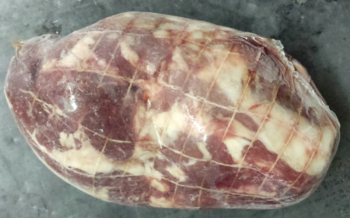
A nicely processed boneless half-shoulder roast, double-wrapped in plastic wrap and then Cryopak. Note the tight seal and the absence of air pockets. Photo: Dave Scott, NCAT
A lamb marketer often begins her business by selling a few wholes and halves to friends and neighbors. In subsequent years, she may branch out to farmers markets. At this point, she may still be selling wholes and halves. It is easily argued that selling in these quantities is the most profitable manner to market your meat. There are fewer costs and the lamb is out the door in a relatively timely fashion. It is wonderful if you can continue expanding your market each year with this model. However, most entrepreneurs find that at a certain point, they must sell individual cuts in order to increase their volume of sales, which will require subtle changes in marketing style.
The Package Itself
Clear Cryopak is essential if you are direct marketing retail lamb cuts. First appearances create first impressions of quality. Sub-par packaging is perceived as lower-quality meat. High-quality packaging, on the other hand, allows you to capture your customer’s attention, focusing on the cut in the package. Because this initial appearance can often make or kill a sale in the marketplace, be it a grocery store, a farmers market, or a restaurant chef’s keen eye, it is crucial to work with your butcher to find the best way to package your product. A preliminary wrap of clear plastic to preserve freshness is an excellent first step. Beyond that, there are two methods: vacuum pack and Cryopak. Both have their advantages and disadvantages. We have found that vacuum packs work well on grind, with superior presentation and a minimum of broken seals and leaking packages.

This lamb herb sausage by KJ’n Ranch in Helena, Montana, is packed in a roll, or chub package. Photo: Dave Scott, NCAT
Somewhat new is the use of clear “roll” or “chub” packaging for grind. This packaging has the advantage of efficiently using shelf space in the retail counter and is quickly gaining in popularity. The disadvantage with rolls is that they can have a small amount of product exuding from the clipped ends. This is cause for concern by some retailers.
Dipped Cryopaks work well on leg and shoulder roasts, while vacuum packs work nicely on chops and racks. Whichever way you choose to package your meat, keep in mind the three objectives of packaging: presentation, functional integrity of the package, and retailer acceptance.
Lamb Differs From Beef
Your lamb product is further distinguished by how professionally the aged carcass is cut. Due to variances in conformation, a lamb carcass is broken down differently than a beef carcass. The most notable differences are how the shoulders, legs, and shanks are broken from the racks and loin. For a look at how a lamb carcass is broken down, see the ATTRA video Creating an Excellent Relationship with Your Lamb Processor. A lamb is broken at the shoulders about two inches ahead of the shoulder blade. As a result, about one quarter of the lamb shoulder remains with the rack. The leg is also broken from the loin differently in lamb than beef. This juncture of the loin and leg is called the sirloin. Although it is some of the most tender meat in the lamb, the sirloin also contains more bone than the loin, and for this reason, it is best if it is not included with the loin chops. Customers who are paying a top price for a loin chop tend to complain if the sirloin is made into a chop. The meat is typically either cut out and put into kabobs or included with the leg. Additionally, the fore shanks and hind shanks on a lamb are valued as high-quality cuts and a maximum amount of meat is left on them. This differs from a beef animal, where the meat is trimmed off the shank and made into grind. As you can see, there are distinct differences in breaking down the two species and it is, therefore, important to work with a butcher who is familiar with processing lamb.
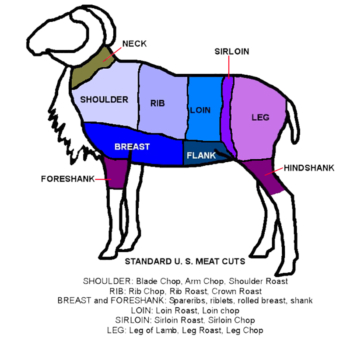
Graphic: United Horned Sheep Association
Special Considerations
A few cuts of lamb are benchmark cuts that deserve special attention. If you sell to restaurants, the racks, or rib section, will be your signature cut. Racks should have one-quarter inch of continuous fat covering, enough for herbs and spices to be conveyed deep into the meat.
Sometimes the rack covering can be torn when removing the hide. This greatly decreases both the presentation and the cooking merits of the cut. Save those less-than-perfect cuts for yourself or for someone who does not mind the imperfection. However, restaurants do mind; forcing their hand will lower your reputation and your sales.
Conversely, racks with too much finish must be trimmed, resulting in more labor from the butcher and more cost to you in terms of unnecessary feed. One of the best ways to enhance relations with your butcher is to present him with a nicely finished animal. He enjoys working with a lamb that exhibits quality throughout.
Although there are differences of opinion, most lamb consumers prefer loin chops that have about an eighth inch of fat trim around the meat. This is enough to give it a delicious flavor, yet still be considered lean. In general, if you have done your part in finishing the lamb to 0.20 inch of back fat, there will be little for the butcher to trim off.
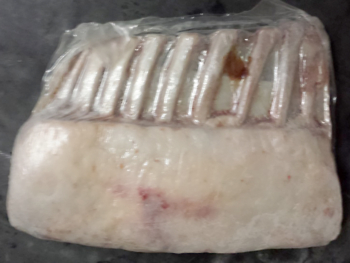
A nicely prepared rack of lamb. Photo: Dave Scott, NCAT
The shoulder cuts also exhibit the butcher’s skill. The shoulder has connective tissue and “tough” fat that must be trimmed away to present a desirable cut. This is particularly true in the case of shoulder kabobs. Unless this connective tissue and its associated bit of meat is trimmed and put into grind, it will result in kabobs that are inconsistent in tenderness. This is too often the case, and it can cause the meat marketer to give up and use the shoulder for grind. This results in a financial loss of $1 or $2 a pound. Shoulders comprise up to one quarter of the lamb carcass, with a 130-pound lamb often yielding six to seven pounds of shoulder kabobs. By capturing this meat, an excellent processor can often contribute $10 to $15 to the boxed value of the lamb. This is a significant increase, one that should not be overlooked.
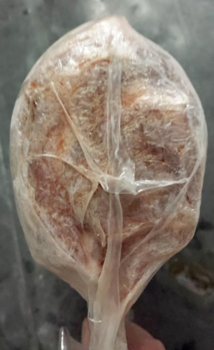
Note the capacious rib eye. Photo: Dave Scott, NCAT
Another example in which the skill of the butcher translates to economic gain for the lamb producer is in processing the trim into grind. Trim is the meat trimmings removed from all of the primary cuts that are not suitable to be included therein. Any excess fat needs to be removed from the trim in order to make a quality grind. This excess fat is a small but notable amount. Too much fat will produce ground lamb that will likely to be rejected by the consumer, especially when it is packaged in clear packaging. It is best to shoot for a ground product that is 85% meat and 15% fat. Ideally, the trim should be ground at 32°F to 34°F in order to be packaged as a crisp, engaging product. Additionally, grind must be frozen quickly. Anything that slows the freezing process (excessive stacking of the packages in freezer, or too-slow freezing, for example) can result in discoloration of the meat. Ground lamb that is attractively presented in its package is one of the best-selling of all lamb cuts.

A rack with an undesirable tear in the finish, or fat
covering the meat. Photo: Dave Scott, NCAT
See the appendix for a summary of the primary retail lamb cuts and the best ways to process each cut, based on our personal experience. In summary, a superior cut begins with a lamb that is correctly finished with just the right amount of fat cover. The finish ensures a tender, flavorful meat and provides a tasty vehicle to insert savor in the form of herbs and spices into the soft meat. The lamb processor continues the excellence by dry aging the lamb and then breaking it down into packaged cuts that compel the customer to purchase them. To achieve this, the producer and the processor must work in concert.
Fulfilling the Customer’s Need
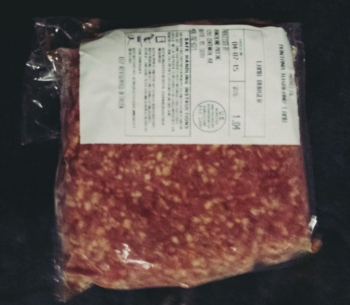
A package of lamburger displaying about 85/15
meat-to-fat ratio and attractive color. Perception and
appearance drive customer sales. Photo: Dave Scott,
NCAT
Acquainting yourself with your customers allows you to serve them in a more personal way. Some customers prefer their lamb to be finished a little more than 0.20 inch of back fat. Lamb connoisseurs from the United Kingdom are noted for this. With your individualized finishing system, you can easily meet this need in providing a whole lamb for them. Others may prefer a lamb finished a touch less than 0.20 inch of back fat. You can meet this request, too, but be careful. The marvelous taste and tenderness of lamb is embodied in the correct amount of intra-muscular fat, or marbling. A lamb that is too lean will have insufficient marbling, which translates to poor taste and tenderness. A superb dining experience fosters repeat customers. Often, preconceived notions on the merits of leanness are abandoned when put to the taste test. Taste frequently outweighs ideology. It is a good practice to keep written notes on your customer’s buying preferences. This can be as simple as an invoice book or as complete as an Excel spreadsheet. Record your customers’ preferences, whether they indicated they might like to try a whole lamb the next year, and when they are most likely to purchase their lamb. A call to them at the appropriate time scores points for you and often leads to a sale. A pleasant-but not pushy-call can also keep you in touch with customers who have not purchased from you in a while. People’s finances can change from year to year and a friendly call can remind them of how they loved your lamb and hopefully result in a sale.
Encouraging customer feedback also keeps you aware of consumer trends with respect to lamb cut preferences. Emphasis on a certain cut on cooking shows or in magazine articles spurs consumer demand. Be ready to supply it. Always keep an ear to the ground and be willing to adapt to new directions in consumer demand.
We have found that most of our customers value home-grown, pastured lamb free of hormones, antibiotics, and GMOs. Such locally grown lamb, with its associated lower cost, often is chosen over organically grown for customers who know the farmer. However, make it your job to cater to the customer’s needs. If you offer non-organic, natural lamb, and a customer desires organic lamb, give him contacts for some organic lamb producers. Both the customer and the producer you refer them to will appreciate your thoughtfulness. Sooner or later this appreciation will return to you, most likely through a future sale.
Finally, never compromise on quality-this is what distinguishes your lamb and fulfills the customer’s desire for a healthy, superior product. Always follow through with anything that you commit to, even if it hurts you monetarily in the short term. Your personal integrity is reflected in the integrity of your farm practices. The provision and sale of good, wholesome food is founded on the trust that the consumer has in the farmer. A smart entrepreneur is always seeking to enhance that confidence as he meets the needs of his clientele.
Promoting Your Product: Basic Marketing Skills
Telling the Lamb Story
Promoting your product can also serve to educate the consumer. Most of us enjoy learning about new things. This is advantageous because, most often, selling lamb involves telling the lamb story.
For most Americans not accustomed to lamb, there is a quick and almost instantaneous response: lamb is terrible stuff! There are two main reasons for this reaction. First, those customers whose fathers fought in World War II likely heard all about the awful “sheep” in C-rations that were served to every soldier. The sheep in C-rations was mutton, not lamb. Mutton is the meat from an old, unpalatable ewe. Only knowledgeable cooks who are experienced in preparing mutton can make the dish delicious. Certainly not the U.S. Government in wartime, 1942.
Secondly, you may run into offspring of ranchers who also ate mutton-again, not by choice, but by necessity. Their frugal parents sold the ranch’s premium livestock (lambs and steers) and presented the cull ewes and cows as dinner on their table. Nothing can be worse for the palate than a leg of mutton and the smell of greasy, poor-tasting fat permeating the dinner air. This unsavory heritage is what you as a lamb marketer may sometimes have to overcome.
To those customers who refuse to try lamb, we ask if they have tried it lately. This is often enough to make the customer stop and consider. A smile, a free sample, a recipe, and a request to come back next week with a report are usually enough to get the customer to try your lamb. Likely as not, they will be back at the next farmers market and eager to buy more. Take the opportunity then to acquaint the customer with yourself and your farm. Tell him the reasons why you are a farmer, and why you enjoy producing good, wholesome food for his family. Convey that one of the main reasons you are a farmer is that you love animals and enjoy paying particular attention to their care and well-being. The use of photos, or, better yet, a digital slide projector, will further draw him into your farm. Invite the family out to see the farm and the animals. Let the customer sense that each time he buys your lamb, he is purchasing a piece of the country with all of its beautiful sights, sounds, and smells. Buying your product gives the customer a vested interest in your farm.
Differentiate Your Lamb
Once you have a potential customer’s attention, differentiate your lamb from that of your competitors. Start big in scope and narrow down. It’s easy for a customer to grasp that lamb produced in Australia and shipped on a boat 11,000 miles is not going to be as fresh as your lamb that is raised locally. Describe how your lambs freely roam on green pasture for most of their life, and this, along with the genetics in your flock, is what produces such mild-tasting meat. Tell how you finish your lambs, letting customers know that you have a proven system for producing that delicious product they just sampled. Mention that your lamb is antibiotic, hormone, and GMO-free. If it is certified organic, stress that. Detail how you go through all of your lambs weekly and select out those that are finished (see the ATTRA video Putting a Hand on Them — How to Tell When Your Lamb is Finished) and ready to be processed. Reinforce that it is just not possible for a big feedlot to do that and explain that while these efforts increase the price somewhat, it is worth it. Then encourage them to buy your lamb and experience the difference in quality themselves.
You can also take advantage of your unique geography. At Montana Highland Lamb, we convey to our customers the environment in which our lambs are raised: high-altitude pastures with pristine water flowing through mountain valleys. Call it the Montana Mystique, if you will; it does sell lamb.
Recipes and brochures highlighting the heritage of lamb producers and health merits of lamb also will increase your sales. The American Lamb Board has a wonderful website full of recipes for all cuts of lamb. The website is an effective way to reach out to the young, tech-savvy customer. If a potential customer asks you about recipes for leg of lamb (an inevitable question), direct her to American Lamb. In no time, she can be online seeing 50 recipes for herself. It is instant credibility and a fresh bond between you and your customer.
Let Your Lamb Sell Itself
Your integrity and the excellence of your product are the best possible advertising you can put to use. For many retail lamb businesses, word of mouth is the primary advertising strategy. There is no better form of promotion than a happy customer. A Facebook page sprinkled with complimentary reviews and customer-submitted recipes that showcase your lamb intrigues and attracts new clientele. Farmers markets provide a venue not only for selling your product but also for letting others promote it for you—a gathering of like-minded customers eager to tell others what they enjoy eating. Word-of-mouth publicity generates more sales for the lamb producer-entrepreneur than any other form of advertising, and its cost is merely your normal manner of conducting business.
Successful marketing is rooted in getting to know your customers, becoming a help to them, and inspiring confidence in yourself and your lamb. Ultimately, your brand begins to stand for a quality product and exceptional service with a personal touch. It is a lofty goal, but one that can be reached sale by sale and one successful relationship at a time.
Labeling Your Lamb Product
The second function of a label is to promote your lamb company. Here you have two avenues to choose from: You can either put your logo on the cut label in the allowed space, or you can opt for the packing plant’s name to be on the cut label and you can include your company logo separately on each packaged cut. There are advantages to each method. For first-time lamb entrepreneurs, opting to have the packing plant’s name on the label is the safest way to start out; you can be confident that there will be no compliance issues. Additionally, it is included in the cost of processing the lamb. A separate logo may also be more eye-catching. The label on each of your lamb cuts serves two purposes: one of function and the other of promotion. Currently, all meat that is sold to the public must be processed in a State- or USDA-inspected plant. This inspection is confirmed by the label. The label must meet standardized criteria. For example, there are up to eight distinct sections on the label that must be completed in order for the label to pass inspection. If just one is missing, you have mislabeled meat and it cannot be sold. If perhaps it makes its way into a restaurant or store, it must be recalled and cannot be sold again. The USDA’s Food Safety and Inspection Service (FSIS) regulations are very specific. It’s important to get your labeling right the first time.
There are up to eight distinct sections on the label that must be completed in order for the label to pass inspection. If just one is missing, you have mislabeled meat and it cannot be sold.
If you choose to use your own cut label, it is best to at least look through the main points in the FSIS’s Guide to Federal Food Labeling Requirements to Meat, Poultry, and Egg Products.
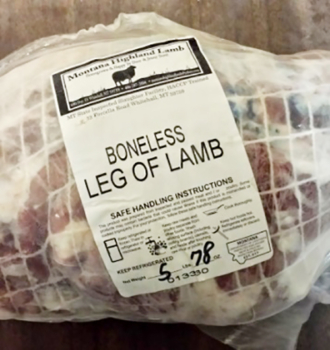
You can have your logo on the standard cut label or you can use the plant’s cut label and an additional brand logo. Photos: Dave Scott, NCAT
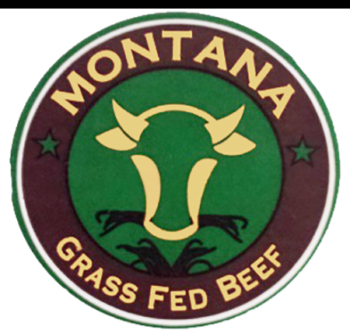
Brand logo example.
A good place to start is Section IV on page 23, “Mandatory Requirements-Introduction.” Then look over “Tips and Pitfalls of Designing a Food Label” on page 3. Afterwards, seek the professional help of your processor and his meat inspector. Ask them both about the labeling requirements for your meat products. Keep in mind that products that have an ingredient list (such as sausage) are in a separate category from whole meat and have additional labeling requirements. Be sure to double-check that your label fulfills all of the requirements before sending it off to be approved by the state. This will save time and a lot of headache.
There is one additional labeling criteria that you must comply with. Country of Origin Labeling (COOL) is required of all lamb meat products, even though this requirement was dropped in 2016 on beef and pork. The American sheep industry has lobbied for 25 years to differentiate American lamb from imported product. At a very minimum, all invoices must clearly state that your lamb is “Born, Raised, and Slaughtered in the USA.” The word “Slaughtered” may be replaced by “Harvested” if you so desire. However, it is advisable that your meat label also contains this COOL phrasing. This labeling requirement is enforced by USDA and information concerning the COOL regulations can be found here.
Use your processor’s connections when choosing a label supplier. Chances are that she has researched the one that provides the best service at the least cost and that her relations with the company are positive.
It sometimes seems that labels fall into the category of “if anything can go wrong, it will.” With this in mind, it’s best to buy a small number of labels at first, even though it may be several times the cost per label. Labels are specific to one processing plant. If you change processors, your labels cannot transfer to another processor. Once you, your processor, and your labels have a proven longevity, you can order a larger quantity, which will save you money.
Allow at least 60 to 90 days to get your private labels. The process can sometimes be very drawn out, but remember that you cannot package any meat without first having the label.
Pricing Your Lamb
Pricing for Profit
All pricing for a profit begins with costs. You must know yours. At the outset, you might assume that if you are selling your premium product to a local market for a premium price, you must be making money. Unfortunately, you could be very mistaken. this was our case. Until we entered the weight of each cut and its associated price from every lamb on a spreadsheet, we did not know we were actually losing money on lambs that finished less than 110 pounds. this was rather eye opening. ATTRA has developed a simple lamb cut-yield calculator that can help calculate net profit.
Profit points are unique to each farm. Position your pricing to ensure that you make a return. You can find more information in the ATTRA publication Planning for Profit in Sustainable Farming.
Pricing: A Place to Start
Once you know your production and marketing costs, you can then investigate the current market. A good beginning resource is the USDA Ag Marketing Service’s (AMS) boxed-lamb cut pricing report, which averages the last five days of boxed-lamb pricing on the open market.
In the meat trade, all cuts have a numbered code, and the AMS report mentioned above requires some familiarity with these codes. An illustrated guide to the coded cuts is available in the North American Meat Institute’s The Meat Buyers Guide. The printed guide can also be sourced from Amazon. The price ranges from less than $20 (used) to over $60 (new).
Your butcher will also be valuable in helping you understand the many variations of cuts.
The AMS pricing report can be used as your base price. To this, you must add margin percentages to arrive at your wholesale and retail prices. For example, fresh boneless leg, trotter off, for the week of May 13, 2015, traded for $6.09 a pound. To this base price, you might add margins of 20% and 30% respectively to determine your wholesale ($7.30 per pound) and retail ($9.50 per pound) pricing. The AMS report is a good way to keep up with market changes.
AMS also has a monthly Grassfed Lamb and Goat Meat Report with a more generalized description of cuts. this report is very useful for the direct marketer, even if he does not sell a grassfed product. For example, a percentage of the grassfed price may be used to determine your pricing. this is a quick and easy way to set an initial price for your lamb cuts.
Are You Competitive?
Once you have established your cut pricing, you must be sure that you are: 1) making a profit; and 2) competitive. The lamb cut-yield calculator mentioned on this page will help you assure profitability. You can confirm your competitiveness by selling your product at farmers markets, where you can easily interact with your customers, and by talking to restaurants and store managers. Farmers markets are a great place for price discovery. Recognition of the added value of your lamb is easy to ascertain. If there are not a significant number of people that tell you your lamb is absolutely the very best they have ever tasted, it may be wise to graciously exit the direct-market business. Selling to the demanding consumer is too much of a gamble and outright work to try to sell a mediocre product. On the other hand, rising sales and positive feedback create consumer trust in your lamb. this supports a price that is profitable.
Finally, research your competitors. Understanding how they produce and market their product can give you insight into how you can stand out by being different. Perhaps you can differentiate yourself from them through alternative production practices, such as organic or grass-based, or a specialized accreditation, such as Animal Welfare Approved. Special year-long pricing or consistently offering a certain cut at an attractive price can also contribute to distinction. Similarly, first-class service, such as personal delivery to customers, can be used to set your company apart from others. Be sure your buyer understands how your unique style of business is of value to him.
Moving Cuts That Don’t Want To
Successfully selling cuts of meat that don’t easily move is often the key to a flourishing meat business. Typically, the most profitable way to market your lamb is in the form of wholes, halves, or bundles. However, as previously mentioned, if you are direct marketing a large number of lambs, this may not be possible. Hence, individual cuts will likely be the majority of your sales.
Have a Plan
Some beginning lamb-entrepreneur businesses start their sales operations with the guaranteed sale of a certain amount of racks or chops, coupled with the enthusiastic hope that they can sell the rest of the cuts. this is not a good idea. You want to have a plan. In a typical lamb, one-half of the boxed product is comprised of leg and shoulder. These cuts comprise the majority of the lamb, yet are often the hardest to sell, resulting in quite a conundrum: one that has stymied its share of start-up lamb businesses.
A strategy is essential. Farmers markets are terrific places to note changing customer trends and preferences. Consumers are influenced by all kinds of advertising, chef cooking shows on television, and YouTube gourmets. Ask your customers how they prepare what they eat. Be flexible in what you have to offer. Transform your least-desirable cuts into another form that will sell better. For example, lamb shoulders can be made into rolled roasts, shoulder steaks, ground lamb, or kabobs. Which will sell best this year? It’s a guessing game, but you can influence the outcome by offering different modes of the same cut and ways to use them. This can reduce the amount of unsold meat in your freezer.
One great way to boost sales is to offer recipes. You can find many innovative and easy recipes at websites such as American Lamb or Pinterest and share them with your customers so they can imagine the finished meal. Marinades can often turn a lesser quality piece of meat into a delicious dish. Customers enjoy being creative, especially when you show them how.
Pricing to promote the sale of lesser cuts also works well. In this strategy, pricing of high-demand cuts is elevated enough to buffer lower price points for lesser cuts in order to encourage sales. Figuring out a decent return requires the use of a spreadsheet or cut-yield calculator to determine your net income with various cut yields and pricing. You also need to employ market savvy. this savvy is gained by understanding the price customers will gladly pay and the point where they start resisting. Farmers markets are excellent testing grounds for determining price pressure points. A good marketer floats a price, notes the response, and then adapts.
It is critical to succeed in marketing lesser-demand cuts at a price that guarantees profitability. Frozen meat only stays fresh for several months before quality begins to erode. Un-marketed cuts are a drag on your bottom line and a recipe for an unprofitable business. Have a workable plan.
Market Venues
The successful direct marketing of your lamb hinges upon the grassroots movement in “knowing your farmer,” through which consumers place value on knowing the farmer who supplies them with their food. Farmers markets, CSAs, restaurants, retail stores, and online marketing are venues that connect the farmer entrepreneur with the consumer. All five have their advantages and disadvantages. It is important to remember, though, that the consumer drives your alternative lamb marketing. If you lose touch with consumer preferences, your lamb business will sputter.
Remember, children often accompany their parents. Anything that captures their attention will help draw prospective customers to you. One year, we displayed a robin’s nest that we had found, which had blown out of a tree. It contained small bits of our sheep wool that the parent birds had interwoven into the twigs. It was a great hit with children and allowed us to talk to their parents about our farm and our lamb.
Your Farm
In addition to finding ways to bring the farm to your customers, invite your customer to your farm. Lambing time is special. Children love to see and hold baby lambs, and you can show how you care for your sheep. You can also give them a tour of the sheep out on pasture and let them see for themselves why your lamb tastes so good. We emphasize to our visitors that we strive to give our lambs the happiest of lives while they are in our care. We also explain our procedure for determining when each lamb is correctly finished. Most people are very impressed that you can tell with your hands when a lamb is ready to be that perfect fare on their plate. In essence, your care and knowledge about the animals in your charge inspires them to adopt you as their farmer. They have you, and you have them: what could be better?
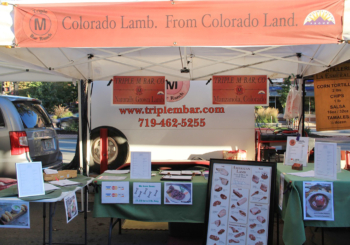
A well-designed market booth draws the customer’s attention to the entrepreneur. Photo: Mary Miller, Triple M Bar Ranch
Farmers Markets
At farmers markets, the full retail price of product can be charged, hopefully justifying the costs of labor and transportation that are involved. Satisfied customers can generate the equivalent of a farmer-entrepreneur “home run” when delicious cuts inspire them to buy a whole lamb. Through customer feedback, producers also have the satisfaction of selling to a pleased and grateful public, something that is not reproduced in any other form of food marketing. For strategies and considerations for selling in farmers markets, see the ATTRA publication Tips for Selling at Farmers Markets. For more tricks that you can employ to garner the customer’s attention, study the New Farmer’s Guide: Cultivating Success at Farmers Markets, produced by Farmers Market Federation of New York. These two resources can help you master attracting potential customers to your booth and to your product.
There are drawbacks, however. Farmers markets take a lot of time and energy. Often, depending on the size of the market and the time it takes to get to it, the farmer-entrepreneur cannot justify employing a full-time salesperson, even though the work load does. This eventually causes many farmer market vendors to sell to restaurants at a wholesale price.
Restaurants
Seven Keys to Excellent Restaurant Relationships
- Never sacrifice quality, period.
- Price just opens the door. Quality and service keep it open.
- Be patient and persistent, but not pushy.
- Chefs are very busy. They keep odd hours. Call accordingly.
- Serve your present customer base well before expanding.
- Free samples smooth over mistakes.
- Above all, be honest. Don’t promise what you cannot deliver.
Restaurants provide lamb entrepreneurs with a steady and relatively high-volume demand for your product. Often, a single delivery run to restaurants will generate more revenue than hours at a farmers market. this makes up for the necessity of selling your lamb at a wholesale price.
Selling to restaurants requires building relationships with chefs. The quality of your lamb and the fact that it is locally raised are major selling points. These are counterbalanced by the fact that it is not as convenient for a chef to buy from local producers. Wholesale food distributers offer a much more efficient manner for her to source her raw product. As a lamb purveyor, you need to be able to supply the cuts the chef needs, when she needs them. Let her know your delivery schedule. Some chefs are very good about keeping in touch with you; some are not. It is best to always make a call before you or your distributor leave on a delivery run. If you are delivering yourself, try to coordinate your deliveries with your trips to farmers markets, thus saving delivery costs.
Many restaurants that serve lamb wish to only serve racks, which is standard menu fare. Unfortunately, there are only two racks per lamb and they only comprise one-tenth of the total carcass. It is to your advantage to use those high-demand cuts as encouragement for a chef to utilize other cuts in his main menu, for specials or for entrees. Many chefs realize that you have to sell the whole animal in order to stay in business. Excellent chefs also enjoy the challenge of making a superlative meal out of cuts that are not in high demand such as shoulder roasts, shanks, or riblets. Find those chefs and keep them. It is always better to build strong and friendly relationships with a core of chefs that you can realistically satisfy than to spread yourself thin over many and supply no one very well.
Restaurant customers love to hear the story behind your farm, too. Provide the restaurant with a small table flyer that describes your lamb product, your philosophy on raising food, and what makes your farm stand out.
The biggest drawback in selling to restaurants is that chefs come and go. Quite often, a new chef means a new menu and you will have to start over again building the relationship that you desire. Sometimes, however, he takes to his new establishment an appreciation of your product and you have a new customer! The volume of product sold through restaurants makes them a very valuable part of a lamb entrepreneur’s customer base. For more useful suggestions on selling to restaurants, see the ATTRA publication Tips for Selling to Restaurants.
Institutions: Reliable Gold Mines

Restaurants represent a valuable part of a lamb entrepreneur’s customer base, due to the large volume of product they buy. Photo: American Lamb Board
Institutions are another marketing outlet you can explore. Some institutions are looking for meat with the beneficial properties of lamb. Ground lamb, for example, is sought after by hospitals and senior living facilities because they recognize the excellent digestibility qualities of lamb. Furthermore, senior living centers that specialize in high-quality care are often seeking to include meals that their members enjoyed when they were more independent. Premium cuts of lamb are attractive to them.
It is also worthwhile to extol the virtues of your fine lamb to local universities. They will often cater special events, which are a perfect venue for leg of lamb. In fact, events are one of the best ways to sell legs, due to the volume of diners gathered in one place. Don’t forget that every university dining hall has an “event” three times a day. Universities are also increasingly interested in providing local food for their students. Sometimes they will feature specials that showcase local producers and their farm products.
Did someone mention national parks? Another great potential customer. Get in on the game! Retail stores and meat CSAs present additional opportunities for selling your lamb. The same requirements of providing a consistent supply of meat with a local flavor apply to these markets also. The ATTRA publications Tips for Selling to Grocery Stores and Tips for Selling through CSAs-Community Supported Agriculture offer helpful hints for using these venues. Finally, don’t forget the huge impact that social media can have on direct sales to the consumer. Social media platforms such as blogs, Facebook, Instagram, and Twitter are great ways for lamb businesses to easily share information about their products, network with new people to build a loyal customer base, and stimulate market traffic.
Summary
The most important factor in marketing any food product is the quality of the product itself. A lamb producer-entrepreneur must learn how to raise, finish, and process his lamb to the degree that the finished product unquestionably demands the attention of the consumer. The lamb product must also fulfill a customer need, even if that need has to be inspired through education. Furthermore, successful sale of lamb meat is dependent upon branding of the product as a unique entity, emphasizing to the consumer why the product is especially suited for him. Willingness to adapt to changing market demands keeps your product at the forefront. Seeking alternative meat markets for your sheep enterprise is more labor- and management-intensive; however, the increased net profit generated by direct marketing often enables the small producer to survive in a marketplace dominated by commodity pricing. Investigate the potential!
References
Guidelines for Humane Handling, Transport and Slaughter of Livestock. Chambers, Philip G. and Temple Grandin. 2001. Food and Agriculture Organization of the United Nations, Regional Office for Asia and the Pacific. RAP Publication 2001/4.
Carcass Dressing Percentage and Cooler Shrink. Schweihofer, Jeannine P. 2011. Michigan State University Extension. May 9.
Further Resources
American Lamb Board Resource Center
A multifaceted resource center for lamb producers. Besides production resources, there are marketing resources that include a pricing calculator, customizable marketing materials, ethnic marketing tools, and promotional tools. This site a must-see for the lamb entrepreneur.
Grass-Fed Cattle: How to Produce and Market Natural Beef. 2006. By Julius Ruechel. Storey Publishing. North Adams, MA.
This comprehensive guide covers every aspect of raising healthy and thriving grass-fed cattle, offering advice on herd selection, pasture management, medical care, necessary equipment, winter grazing, slaughtering procedures, and more. With tips on creating a viable business plan and identifying niche markets for your beef, Ruechel provides everything you need to know to develop a profitable and environmentally sustainable grass-fed cattle operation. The concepts discussed can easily be applied to a lamb direct-marketing business.
Meat Marketing Planner: Strategic Marketing for Farm-to-Table Meat Enterprises. 2013. By Ginger Myers. University of Maryland Extension. EB-403. This bulletin addresses marketing beef, pork, lamb, and goat, but not poultry since poultry processing falls under differing USDA, FSIS, and state regulations. While many of the key strategies discussed here can be applied to the sale of any farm products direct to consumers, this publication focuses on marketing farm-raised meats.
The New Livestock Farmer: The Business of Raising and Selling Ethical Meat. 2015. By Rebecca Thistlethwaite and Jim Dunlop. Chelsea Green Press. White River Junction, Vermont.
This book provides pasture-based production essentials for a wide range of animals, from common farm animals (cattle, poultry, pigs, sheep, and goats) to more exotic species (bison, rabbits, elk, and deer). It offers a clear, thorough, well-organized guide to a subject that will become increasingly important as the market demand for pasture-raised meat grows stronger.
The New Farmer’s Market: Farm Fresh Ideas for Producers, Managers, and Communities. 2005. By Vance Corum, Marcie Rosenzweig, and Eric Gibspon. 2015. New World Publishing. Auburn, California
Helping to increase local market success for both farmers and customers, this book serves as a three-part guide to marketing, being a resource for farmers or market gardeners selling their produce at farmers’ markets; for city planners or market managers in starting and building a market; and for community activists and city planners trying to foster appreciation for farmland while reinvigorating economic and social vitality in urban areas. Appendices cover insurance, customer surveys, farmers market profitability, and benefits of farmers markets.
Direct Marketing Lamb: A Pathway
By Dave Scott, NCAT Livestock Specialist
Published November 2016
©NCAT
IP518
This publication is produced by the National Center for Appropriate Technology through the ATTRA Sustainable Agriculture program, under a cooperative agreement with USDA Rural Development. ATTRA.NCAT.ORG


